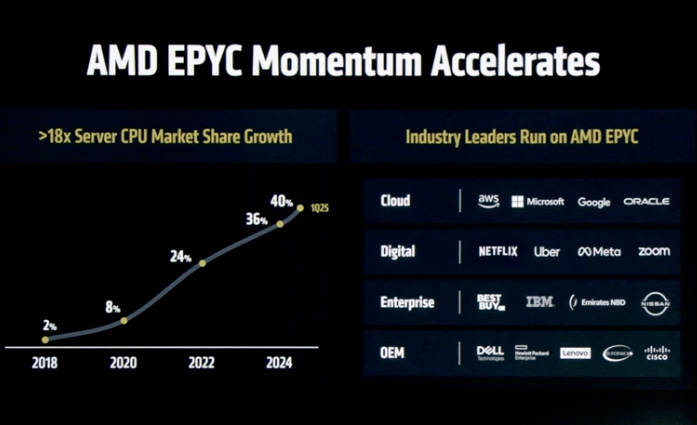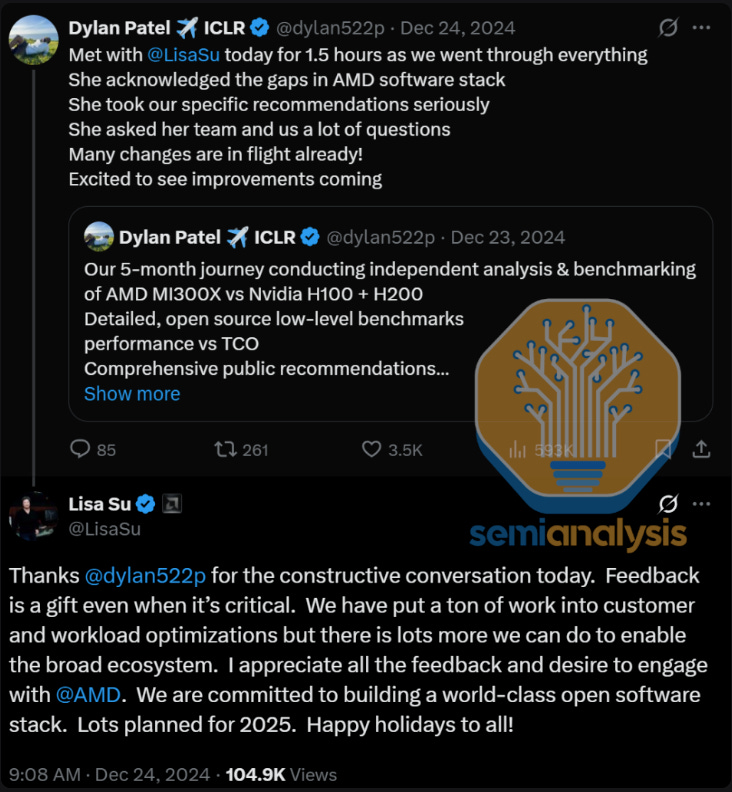AMD Advancing AI 2025: Key Takeaways
AMD held their “Advancing AI 2025” event on June 12 last. It was an impressive affair and included testimony from a wide range of key customers including Meta, OpenAI, xAI, Oracle, Microsoft, Cohere, HUMAIN, Red Hat, Astera Labs and Marvell. CEO Lisa Su’s keynote opening the event can be found here.
In here opening remarks, Lisa Su highlighted the progress has AMD has made in gaining data centre market share, growing from just 2% in 2018 to 40% in Q125.
With all of the recent excitement (and hype) around AI acceleration, it’s easy to lose sight of what a remarkable accomplishment this has been for AMD. I’ve been writing about AMD’s data centre ambitions for quite some time, but our note from November 2022 provides a good background on how the journey got started and why it was so significant for the company:
AMD. It's All About The Data Center Now
AMD’s reversal of fortunes over the course of the past six years has been a fascinating journey to observe. We published our first ever article on the topic back in May 2018:
I fully expect AMD to continue to take data centre market share from Intel for at least the next two years until Intel finally, possibly, gets its act together on the server side. On top of this, AMD is now competing vigorously in the AI acceleration market, having gained its original foothold in the Supercomputer segment.
Supercomputing is a segment that often gets overlooked these days, but it remains an important one for AMD, with the company now powering the top two most powerful supercomputers in the world, details from AMD here on June 10.
At ISC High Performance 2025, AMD again demonstrated its HPC leadership with the El Capitan and Frontier systems retaining the No. 1 and No. 2 positions on the latest Top500 list.
AMD powered system ranked as the world’s most powerful supercomputer for the seventh consecutive Top500 list
172 systems (34%) on the latest Top500 list now use AMD
AMD powers 12 of the top 20 most energy-efficient supercomputers in the world
Of course all eyes are now focused on what AMD can achieve with its Instinct line of accelerators. You may recall that in 2024, AMD almost doubled their annual data centre revenue YoY, with Instinct accounting for $5 billion of that:
Data Center segment annual revenue nearly doubled as EPYC processor adoption accelerated and we delivered more than $5 billion of AMD Instinct accelerator revenue.
Now, AMD continues to see growing industry adoption for Instinct products with seven of the ten largest AI companies now on board:
During her keynote, Lisa Su doubled down on her view that data centre AI accelerator TAM will grow to more than $500 billion by 2028. This time however, she breaks the TAM into its training and inference components and notes that while the overall market will grow at a 60% CAGR, the market for inference will have a >80% CAGR.
In order to gain meaningful market share in this market, AMD needs to greatly (and rapidly) improve its software stack, ROCm. This fact is not lost on Lisa Su and she openly acknowledges the challenge that lies ahead in this regard.
You can get a good sense of the progress being made here from this recent
aka SemiAnalysis articleSo what else stood out from AMD’s Advancing AI 2025 event? Sam Altman’s appearance was definitely a highlight, as was Oracle’s big announcement:
Oracle and AMD today announced that AMD Instinct™ MI355X GPUs will be available on Oracle Cloud Infrastructure (OCI) to give customers more choice and more than 2X better price-performance for large-scale AI training and inference workloads compared to the previous generation. Oracle will offer zettascale AI clusters accelerated by the latest AMD Instinct processors with up to 131,072 MI355X GPUs to enable customers to build, train, and inference AI at scale.
However, one thing that particularly grabbed our attention was the updates on UALink, AMD’s (and the industry’s) answer to NVIDIA’s NVLink. Let’s dig in…
Keep reading with a 7-day free trial
Subscribe to Semicon Alpha to keep reading this post and get 7 days of free access to the full post archives.









